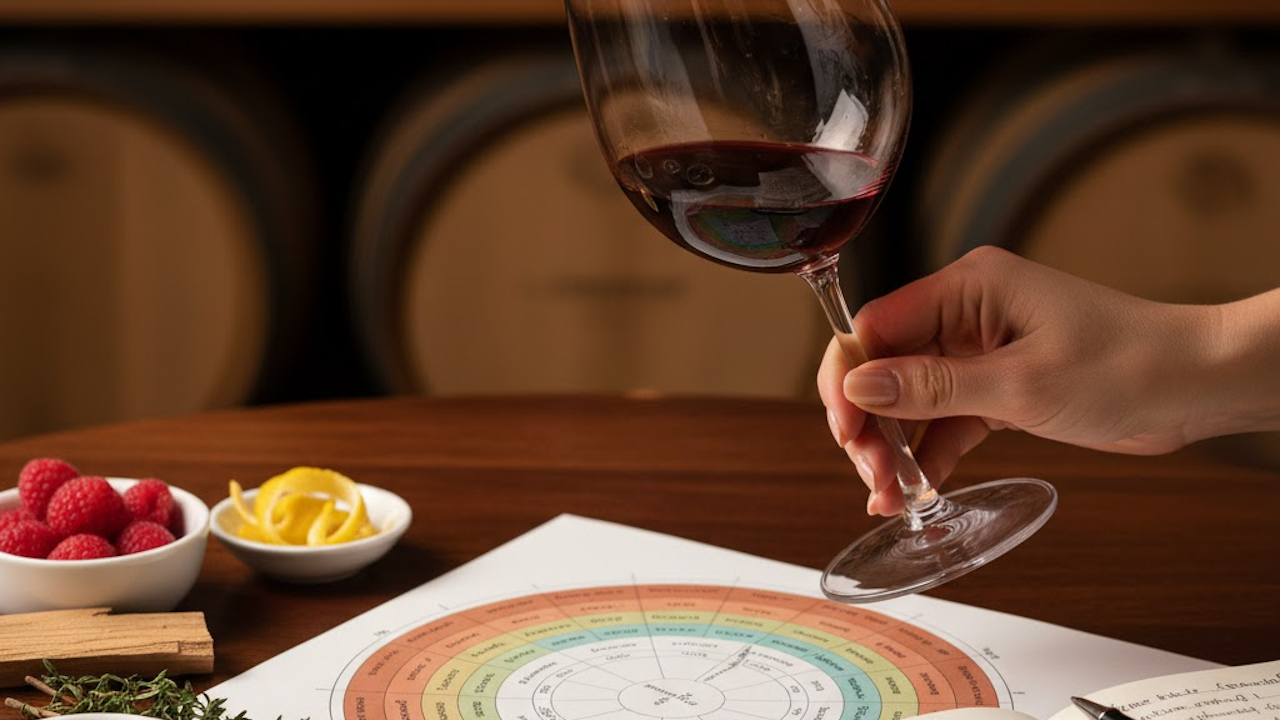Identifying the complex aromas and flavors in wine can seem like a mysterious art reserved for sommeliers, but it is in fact a skill built upon systematic practice and a trained memory. Moving beyond vague descriptors to pinpoint specific notes requires a structured approach that engages all your senses. This is the difference between guessing and analytically describing a wine.
The Systematic Approach to Tasting
The foundation of accurate note identification is a methodology like the Wine & Spirit Education Trust’s (WSET) Systematic Approach to Tasting (SAT). This provides a framework for evaluating a wine across four key stages: Appearance, Nose, Palate, and Conclusion. By treating each stage as a forensic examination, you build a comprehensive profile based on objective observations, not preconceptions.
1. Appearance: The Visual Clues
Before smelling or sipping, the wine’s appearance offers its first set of clues. Look for:
- Clarity: Is the wine brilliantly clear, or is it hazy? Haziness can sometimes indicate a fault or simply an unfiltered wine.
- Intensity: Is the color pale, medium, or deep? A pale red might suggest Pinot Noir, while a deep purple often points to a young, concentrated Cabernet Sauvignon.
- Color: The specific hue reveals age and grape. White wines progress from lemon to gold to amber. Red wines move from purple (young) to ruby to garnet (aged) to tawny (very old).
2. The Nose: Unlocking Aroma Categories
The sense of smell is the most crucial part of wine tasting, as flavor is largely retro-nasal olfaction. Swirl the wine to release volatile aromatic compounds, then take a short, deep sniff. Systematically categorize the aromas into three main groups:
Primary Aromas
These aromas come directly from the grape variety and the vineyard environment (terroir). Think of fruit, floral, and herbaceous notes.
- Fruit: This is the dominant category. Do not just stop at “fruity.” Determine the color and ripeness of the fruit.
- White Wines: Are the fruits green (apple, pear, gooseberry), citrus (lemon, lime, grapefruit), stone (peach, apricot), or tropical (pineapple, mango)?
- Red Wines: Are the fruits red (cherry, raspberry, cranberry) or black (blackberry, blackcurrant, black plum)?
- Ripeness: Are the fruits fresh/unripe, ripe, or jammy/cooked?
- Floral: Notes like rose, violet, or orange blossom.
- Herbal/Vegetal: Notes such as grass, green bell pepper (capsicum), or mint.
Secondary Aromas
These are aromas imparted during the winemaking process, specifically fermentation and post-fermentation treatment.
- Yeast/Lees: Notes like bread, biscuit, toast, or autolytic (Champagne).
- Malolactic Conversion: Notes like butter, cream, or cheese.
- Oak: Notes such as vanilla, coconut, cedar, smoke, or toast from barrel aging.
Tertiary Aromas
Known as “bouquet,” these develop during the aging process, either in a barrel (oxidative) or in the bottle (reductive).
- Oxidative: Notes like coffee, caramel, toffee, nuts, or dried fruit (fig, raisin).
- Bottle Aging: Notes like honey, mushroom, leather, tobacco, or petrol (in aged Riesling).
To avoid guessing, begin with the broadest category (Fruit, Earth, Oak) and then work outward to the specific descriptor (e.g., Fruit $\to$ Citrus $\to$ Lemon).
3. The Palate: Confirming and Evaluating Structure
Take a small sip of wine, let it coat your mouth, and draw in a little air. This process, called aeration, releases the full range of flavors. The palate confirms the aromas while also evaluating the structural components of the wine.
- Flavor Characteristics: Do the flavors on the palate match the aromas on the nose? This is crucial confirmation.
- Sweetness: Is it dry, off dry, medium, or sweet?
- Acidity: This creates a mouthwatering sensation. Is it low, medium, or high? High acidity makes a wine feel fresh and tart.
- Tannin: Present in red wines, this is the drying, astringent feeling on your gums and tongue. Is it low, medium, or high? Are the tannins soft and silky or coarse and gripping?
- Alcohol: Detected as heat or a burning sensation in the back of your throat. Is it low, medium, or high?
- Body: The wine’s viscosity or weight in your mouth. Is it light, medium, or full?
4. Conclusion: Synthesizing the Data
The final step is to combine all your observations to assess the wine’s quality, complexity, and suitability for aging. The key is balance. Do the structural components (acidity, tannin, alcohol) harmonize with the fruit and other flavors? A quality wine is one that is balanced, complex (many layers of flavor), and has a long, pleasant finish.
Essential Tools for Objective Tasting
To effectively transition from guessing to certainty, incorporate these tools into your practice:
- The Wine Aroma Wheel: Developed by Dr. Ann Noble at UC Davis, this visual aid is indispensable. It organizes wine aromas into tiers: the center holds generic categories (e.g., Fruit), the middle tier lists subcategories (e.g., Citrus Fruit), and the outer tier specifies the exact notes (e.g., Lemon). By moving from general to specific, it trains your brain to categorize and identify scents systematically.
- Aroma Standards: The human brain recognizes smells by linking them to memory. Actively smell common descriptors found in the aroma wheel: fresh fruits, dried herbs, spices, coffee, tobacco, and new leather. By smelling real world items, you establish a reliable sensory library for comparison.
- Tasting Notes Journal: Keep a dedicated journal. Writing down your objective observations (color intensity, aroma groups, structural components) reinforces the systematic process and helps you track your palate’s development. The more you taste and record, the faster and more accurately you will identify notes.
Identifying notes in wine is not about an innate ability; it is about applying a structured, repeatable method. By engaging the systematic approach, utilizing the aroma wheel, and actively training your olfactory memory, you can confidently describe a wine’s profile without relying on guesswork.

